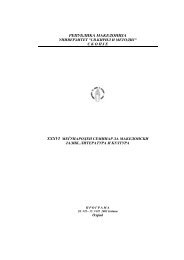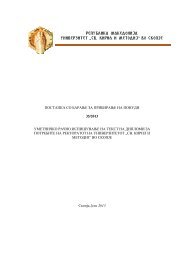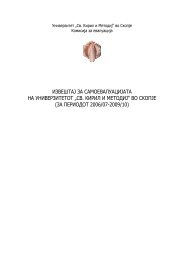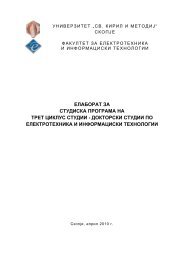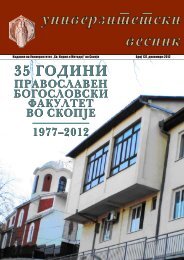УНИВЕРЗИТЕТ „СВ. КИРИЛ И МЕТОДИЈ“ – СКОПЈЕ
УНИВЕРЗИТЕТ „СВ. КИРИЛ И МЕТОДИЈ“ – СКОПЈЕ
УНИВЕРЗИТЕТ „СВ. КИРИЛ И МЕТОДИЈ“ – СКОПЈЕ
You also want an ePaper? Increase the reach of your titles
YUMPU automatically turns print PDFs into web optimized ePapers that Google loves.
154<br />
The basic problem when writing in a Slavic language with a non-Slavic<br />
alphabet is the limitation of the writing system for the sound system of the target<br />
language. The Cyrillic alphabet is, of course, based on the Greek alphabet, but<br />
in Modern Greek, the phonetic values of some of the consonantal graphemes<br />
are different from the phonetic values that the graphemes were chosen to denote<br />
in Slavic. From the Slavic point of view, the Greek alphabet lacks graphemes<br />
for hushing sounds and, naturally, for the affricates they help constitute.<br />
The vowels are characterized by a different complex of problems. All<br />
South Slavic vowels have their equivalent in the Greek alphabet, excluding the<br />
central vowel [ə]. As it is not difficult to find ways to correlate the different<br />
Slavic vowels with Greek letters, it is the abundance of possible graphemes that<br />
poses problems. For example, the monophthongization in Greek has produced<br />
almost ten different ways of denoting the sounds [i] and [e], and it is therefore<br />
important to examine whether or not those various graphemes or digraphs are<br />
used to express actual phonetic differences in the target language.<br />
The Macedonian text is accented throughout, as is the Greek text. The<br />
acute accent and the circumflex are used to denote the word stress (Nuorluoto<br />
2006). Furthermore, the spiritus lenis and spiritus asper are written on an initial<br />
vowel, following the Greek tradition. They do not, however, carry any information.<br />
There are two main sources for the graphemic solutions in the text. The<br />
first one is, of course, the Greek writing system, which functions as the primary<br />
stock for the graphemes, diacritics, and punctuation marks. The second is the<br />
Church Slavonic writing tradition, whose influence is more marginal, but for<br />
which there is still clear evidence.<br />
2. Preliminaries<br />
According to a preliminary interpretation of the text, the manuscript<br />
represents the Lower Vardar dialect of Macedonian (see e.g. Nuorluoto<br />
2006). Therefore, the phoneme inventory of the Lower Vardar dialect will<br />
serve as the phonological hypothesis for the study of the graphemics of the<br />
Konikovo Gospel. The Lower Vardar phoneme inventory differs from that of<br />
the Macedonian standard language by the reflex of the back nasal *ǫ being /ă/,<br />
and by the reflexes of the syllabic *l̥ and *r̥ being /lă/ or /ăl/, and /ră/ or /ăr/.<br />
Furthermore, the non-stressed vowels are reduced accordingly: /o/ > /u/, /e/ ><br />
/i/ and /a/ > /ă/. Another important factor is that there is a mobile stress at the<br />
word level (Markovik’ 2001: 23-24).<br />
The relationship between the hypothetical phoneme inventory and the<br />
Greek alphabet used to depict it is problematic for two reasons. On the one<br />
hand, many phonemes have no direct equivalent in the Greek alphabet. On the<br />
other hand, the Greek writing system includes a great amount of redundancy






